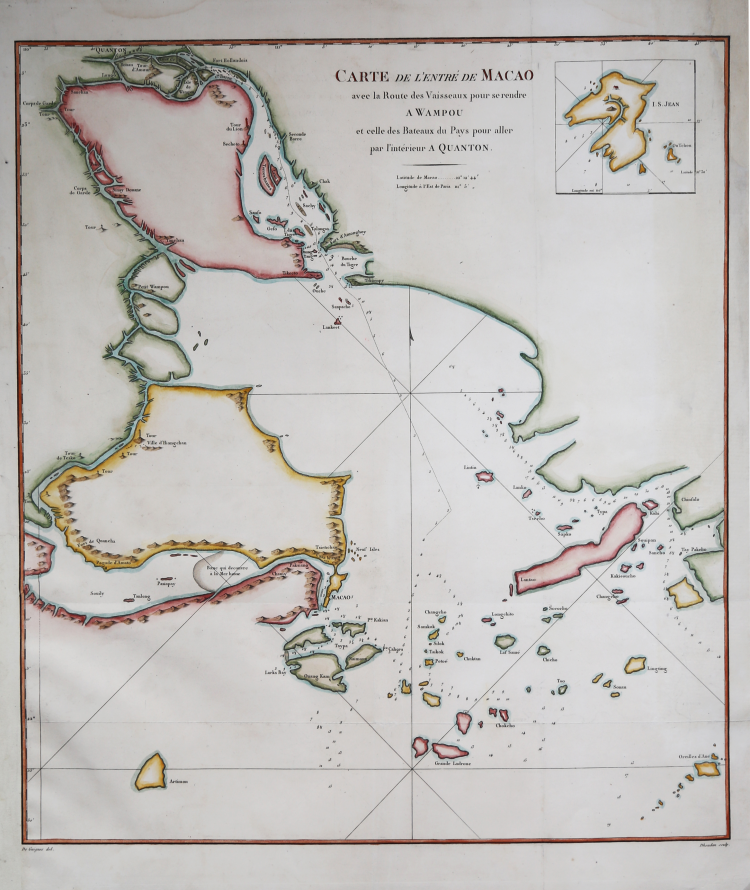




| Reference: | S44271 |
| Author | Chrétien Louis Joseph de GUIGNES |
| Year: | 1808 |
| Zone: | Macao |
| Printed: | Paris |
| Measures: | 428 x 525 mm |



| Reference: | S44271 |
| Author | Chrétien Louis Joseph de GUIGNES |
| Year: | 1808 |
| Zone: | Macao |
| Printed: | Paris |
| Measures: | 428 x 525 mm |
Rare and important nautical chart of Macao, Canton, Lantau, and parts of Hong Kong by Chretien-Louis-Joseph de Guignes.
The map covers the Zhujiang River estuary from Macao (Macau) eastwards to Hong Kong and northwards as far as Canton (Guangzhou). Hong Kong Island and neighboring Lamma are themselves not labeled, though several of the surrounding Islands are, as is Chinsalo (Tin Shui) and Dadongwan (Lingting), among others. The map is primarily a nautical chart and features numerous depth soundings throughout. An inset in the upper right quadrant details Shangchuan Island, a part of the Chuanshan Archipelago.
From de Guignes C.L.J. Voyages à Péking, Manille et L'Île de France, faits dans l'intervalle des années 1784 à 1801. Paris, 1808.
The map is based upon the work of Alessandro Malaspina. The Malaspina Expedition (1789–1794) was a five-year maritime scientific exploration commanded by Alessandro Malaspina and José de Bustamante y Guerra.
The map is drawn from information derived by Chrétien-Louis-Joseph de Guignes from a member of the Malaspina expedition. In 1792, Malaspina's expedition sailed from Mexico across the Pacific Ocean. They stopped briefly at Guam before arriving at the Philippines, where they spent several months, mostly at Manila. After the Philippines, the Malaspina expedition set sail for New Zealand, remaining in Australasia and the South Pacific for the remainder of the expedition.
During his journey, de Guignes made observations on Chinese history, society and culture, geography, economics, and manufacturing. Upon returning to France in 1801, de Guignes published an account of his 17 years of travels through China, the Philippines, and Mauritius, which included two maps of Philippine interest, engraved by D'Houdan, which appeared in the atlas to accompany his travel account, Voyages à Peking, Manille et L'Ile de France faits dans l'Intervalle des Années 1784 à1801, published in Paris in 1808.
Copperplate with fine later hand colour, a repaired area at the upper right margin, otherwise good condition.
Chrétien Louis Joseph de GUIGNES (20 agosto 1759 - 1845, Parigi, Francia)
|
Chrétien-Louis-Joseph de Guignes (1759–1845) was a French merchant-trader, ambassador and scholar, born in Paris, the son of French academician and sinologue, Joseph de Guignes. In 1784, Guignes traveled to China as Resident of France in China and consul at Canton, where he remained until 1801, making periodic trips to Manila during his 17 year stay, where he apparently encountered Malaspina. From 1794-95, de Guignes served as an interpreter while traveling through eastern China with Isaac Titsingh, the Dutch ambassador to the court of the Qianlong Emperor of China. Heading to Beijing to celebrate the sixtieth anniversary of the Qianlong Emperor's reign, Titsingh and his colleagues conformed to the demands of the Chinese court etiquette and succeeded in developing good relations with China. De Guignes and the members of the Titsingh mission were the last European diplomats to appear before the Imperial court until after the Opium Wars of the next century.
|
Chrétien Louis Joseph de GUIGNES (20 agosto 1759 - 1845, Parigi, Francia)
|
Chrétien-Louis-Joseph de Guignes (1759–1845) was a French merchant-trader, ambassador and scholar, born in Paris, the son of French academician and sinologue, Joseph de Guignes. In 1784, Guignes traveled to China as Resident of France in China and consul at Canton, where he remained until 1801, making periodic trips to Manila during his 17 year stay, where he apparently encountered Malaspina. From 1794-95, de Guignes served as an interpreter while traveling through eastern China with Isaac Titsingh, the Dutch ambassador to the court of the Qianlong Emperor of China. Heading to Beijing to celebrate the sixtieth anniversary of the Qianlong Emperor's reign, Titsingh and his colleagues conformed to the demands of the Chinese court etiquette and succeeded in developing good relations with China. De Guignes and the members of the Titsingh mission were the last European diplomats to appear before the Imperial court until after the Opium Wars of the next century.
|